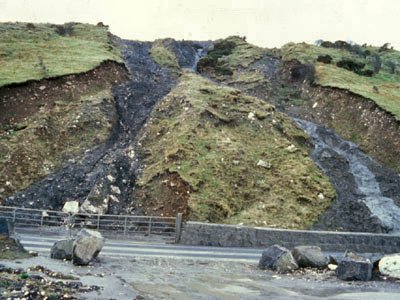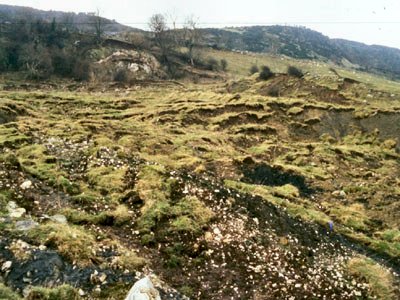Earth Science Conservation Review
| Minnis North Mudflow | Antrim |
| Site Type: | Inland exposure, Landslip |
| Site Status: | ASSI |
| Grid Reference: | D339135 |
| Google maps: | 54.95152,-5.91003 |
| Rocks | |
|---|---|
| Rock Age: | Cretaceous, Jurassic (Campanian, Cenomanian, Coniacian, Hettangian, Lower Jurassic, Lower Lias, Santonian, Turonian, Upper Cretaceous) |
| Rock Name: | Hibernian Greensands Formation, Lias Undivided, Lower, Ulster White Limestone Formation |
| Rock Type: | Greensand, Limestone, Mudstone, Sand |
| Interest | |
| Fossil Groups: | Ammonite, Annelid, Arthropod, Belemnite, Bivalve, Crinoid, Echinoderm, Fish, Gastropod, Nautiloid, Plant, Sponge |
| Other interest: | mudflow |
Summary of site:
Minnis North is important for two main reasons: first, it is the best example of a mudflow on the Antrim coast; and second, the muds yield not only the richest variety of early Jurassic fossils to be found anywhere in Northern Ireland, but also a Cretaceous fauna outstandingly rich in fish teeth.
The rock succession in Co. Antrim places great thicknesses of Cretaceous, largely Ulster White Limestone and Tertiary basalt lavas, on top of the Jurassic strata. The Jurassic rocks are predominantly clays and mudstones that deform plastically under this load and, where they are exposed in the cliffs around the coast, they are extruded on to the slopes. The displacement of these Jurassic sediments leaves the overlying rocks unsupported and unstable, permitting rainwater to penetrate open fractures. This causes further instability because the clays and mudstones expand as they absorb the water and act as lubricants, easing the down slope movement of mud and loose blocks under gravity. In extremely wet conditions, excess water further lubricates the clays, causing phases of visible movement. At present, there are three principal flow paths (or chutes) feeding Minnis North, the two westerly ones merging so that only two directly feed the flow on to the coast road.
The flow is artificially controlled by a wall on the landward side of the road and periodically, as the muds bank against it, they are removed and tipped on to the shore. Rain-wash and the constant combing of the sea releases the fossils.
There are no continuous outcrops on the slopes feeding the chutes, so the age ranges present in the area can only be established from loose fossils. Ammonites, nautiloids, belemnites, bivalves, gastropods and crinoids are commonly found in the Jurassic clays, with sea urchins, brittle stars and corals present, but rarer. There are also remains of vertebrates, particularly ichthyosaurs and, less commonly, plesiosaurs. Both are large marine reptiles. The ammonites indicate that all three zones of the Hettangian stage, the first of the Jurassic period, are present.
Cretaceous fossils are harder to extract, particularly from the Ulster White Limestone Formation, and generally are fewer in number than in the Jurassic rocks. However, sponges, belemnites, sea urchins and marine worms occur here, while the sandstones of the Hibernian Greensand Formation contain the teeth of at least seventeen species of fish (mostly sharks). This fish fauna is unique in Northern Ireland and, surprisingly, shows closer affinities with faunas in Belgium and Kent than with those in the much closer Yorkshire Cretaceous.
The rock succession in Co. Antrim places great thicknesses of Cretaceous, largely Ulster White Limestone and Tertiary basalt lavas, on top of the Jurassic strata. The Jurassic rocks are predominantly clays and mudstones that deform plastically under this load and, where they are exposed in the cliffs around the coast, they are extruded on to the slopes. The displacement of these Jurassic sediments leaves the overlying rocks unsupported and unstable, permitting rainwater to penetrate open fractures. This causes further instability because the clays and mudstones expand as they absorb the water and act as lubricants, easing the down slope movement of mud and loose blocks under gravity. In extremely wet conditions, excess water further lubricates the clays, causing phases of visible movement. At present, there are three principal flow paths (or chutes) feeding Minnis North, the two westerly ones merging so that only two directly feed the flow on to the coast road.
The flow is artificially controlled by a wall on the landward side of the road and periodically, as the muds bank against it, they are removed and tipped on to the shore. Rain-wash and the constant combing of the sea releases the fossils.
There are no continuous outcrops on the slopes feeding the chutes, so the age ranges present in the area can only be established from loose fossils. Ammonites, nautiloids, belemnites, bivalves, gastropods and crinoids are commonly found in the Jurassic clays, with sea urchins, brittle stars and corals present, but rarer. There are also remains of vertebrates, particularly ichthyosaurs and, less commonly, plesiosaurs. Both are large marine reptiles. The ammonites indicate that all three zones of the Hettangian stage, the first of the Jurassic period, are present.
Cretaceous fossils are harder to extract, particularly from the Ulster White Limestone Formation, and generally are fewer in number than in the Jurassic rocks. However, sponges, belemnites, sea urchins and marine worms occur here, while the sandstones of the Hibernian Greensand Formation contain the teeth of at least seventeen species of fish (mostly sharks). This fish fauna is unique in Northern Ireland and, surprisingly, shows closer affinities with faunas in Belgium and Kent than with those in the much closer Yorkshire Cretaceous.
| Enlander, I., Dempster, M. & Doughty, P., 2025. Minnis North Mudflow, County Antrim, site summary. [In] Earth Science Conservation Review. https://www.habitas.org.uk/escr/summary.php?item=114. Accessed on 2025-04-03 |
| Previous Site | Next Site |

